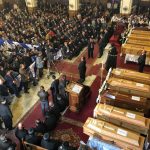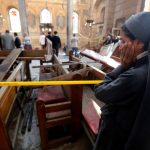By Maged Atiya –
This is a historic site, and excellent restoration can be done, but likely at a painstaking pace. It deserves no less.
***
Several days after the terrorist explosion at the Boutrosiya Church Egypt is still dealing with its repercussions. A state funeral for the 25 victims, mostly women and children, was tightly organized. President Sisi attended and read out the name of the suspect. Later, Pope Tawadros II presided over the services for the victims, who were interned after scenes of heart-rending grief.
Today the Egyptian government announced that the Army will undertake the repair of the Church in 15 days. While the alacrity is commendable, it is also unnecessary, and possibly counter-productive. Anything less than an exacting restoration will add to the grief of the community and further diminish Egypt’s dwindling cultural heritage. The Church represents a unique history and the preservation of its structure to the standards of its builders should be the primary goal of the effort, not speed.
The Boutrosiya was built to honor and serve as resting place for the only Coptic Prime Minister in Egypt’s history, Boutros Ghali, who was assassinated in 1910, in a crime tinged with sectarian feelings. His three sons undertook the construction effort; the learned Naguib, a one time government official and philanthropist; the worldly Wassif, the Foreign Minister who negotiated for Egypt’s independence from Britain, and the private Youssef, who bought and tended his brother’s lands, and was father to diplomat and UN Secretary General Boutros Youssef Boutros Ghali and grandfather to the man responsible for Egypt’s economic turnaround in the late Mubarak years, Youssef Raouf Youssef Boutros Ghali.
The sons spared no effort to build the most magnificent structure they can afford. When Egyptian artisans could not do well enough, they imported Italians. It opened as a trumpet call announcing their faith to fellow Copts, their prominence to all Egyptians, and Egypt’s rising status to outsiders. If the Church was built to project power and status, it was also appropriated for an entirely different purpose by another of Boutros Ghali’s grandsons, Merrit Naguib Boutros Ghali. The grounds served as home for much of Merrit’s cultural interests and outreach. Merrit, a polymath who was fluent in several European and African tongues, established the Society of Coptic Archaeology and ran it from the Church (actually a misnomer since he undertook repair of Islamic antiquities as well).
At one time, the Church contained over 13,000 volumes of books, some exceedingly rare. He made friends with many other scholars, who followed his template to establish other cultural centers and initiated a variety of efforts. Men such as Murqus Simaykah, who founded the Coptic Museum, Yassa ‘Abd El Messih, who cataloged the St Catherine Monastery rare collection, Sami Gabra, who co-founded the Society of Coptic Archeology, and with Aziz Atiya, the Higher Institute of Coptic Studies, Labib Habachi, who excavated Nubia for the University of Chicago, Ragheb Muftah who rescued ancient Coptic Church music from oblivion, and many others too numerous to name in a short post. All these men passed through the Church at one time or another because of Merrit.
These were interstitial men, neither fully Eastern nor fully Western, yet better able to bridge the cultural divides. Most wanted to serve Egypt, but the confluence of Army men and Muslim Brothers made them focus more closely on Coptic culture. Even there, they struggled mightily to raise scholarship to eminence above hagiography, and sometimes suffered Clerical reproach for it. For these men, work was prayer and learning a higher piety. They elevated their fellow Copts, even if the majority is barely able to recall either their names or their accomplishments, much less so other Egyptians.
The notion that the Army can fully and faithfully repair, in 15 days, significant damage to the Church which was a background to these activities seems miraculous. It is more likely that the job will be hastily done to meet a political deadline. The Church hierarchy may feel compelled to accept this seemingly generous offer, but lay Copts, especially those abroad, should advise caution.
This is a historic site, and excellent restoration can be done, but likely at a painstaking pace. It deserves no less. As does the memory of men who strove to elevate their peers. The work of nations is varied, but the building of a nation is primarily cultural. A meticulous effort, supported by a communally raised fund, and done under private supervision of qualified art historians and restorers may well be the single ray of light in this bleak episode.
______________________





